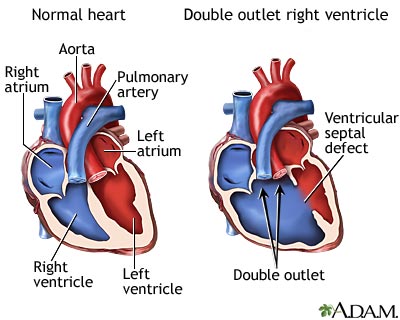Alternate Names : DORV, Taussig-Bing anomaly, DORV with doubly-committed VSD, DORV with noncommitted VSD, DORV with subaortic VSD
Definition
Double outlet right ventricle (DORV) is a congenital heart disease in which the aorta rises from the right ventricle (the chamber of the heart that pumps blood to the lungs), instead of from the left ventricle (the normal pumpng chamber to the body).
Both the pulmonary artery (which carries oxygen-poor blood to the lungs) and aorta (which carries oxygen-rich blood from the heart to the body) come from the same pumping chamber. No arteries arise from the left ventricle (the normal pumping chamber to the body).
Overview, Causes, & Risk Factors
Normally, the aorta arises from the left ventricle (the chamber of the heart that usually pumps blood to the body). The pulmonary artery normally arises from the right ventricle.
In DORV, both arteries arise from the right ventricle. This is a problem because the right ventricle carries oxygen-poor blood, which the aorta then carries throughout the body. Nearly always, DORV also includes the presence of a ventricular septal defect (VSD). Pulmonary valve stenosis may also be part of the defect.
The presence of a VSD helps the infant with DORV, because oxygen-rich blood from the lungs flows from the left side of the heart, through the VSD opening and into the right chamber, mixing with the oxygen-poor blood. However, the body may still not get enough oxygen even with this mixture, and the heart has to work harder to try to bring more oxygen-rich blood to the body.
In addition, because the pulmonary artery receives blood from both ventricles instead of just the right one, blood pressure in the lungs increases. In other cases, because the pulmonary valve and arteries are blocked or narrow, the lungs may not get enough blood.
There are several types of DORV. The difference between these types is the location of the VSD compared to the location of the pulmonary artery and aorta. The type of DORV, and the presence or absence of pulmonary valve stenosis, affect the severity of signs and symptoms the baby may have.
Patients with DORV often have other heart abnormalities such as:
- Coarctation of the aorta
- Mitral valve problems
- Pulmonary atresia
- Right aortic arch
Some may have abnormal coronary arteries (blood vessels that supply the heart muscle).
Pictures & Images
Double outlet right ventricle
 Double outlet right ventricle (DORV) is a congenital heart disease in which the aorta and pulmonary artery rise from the right ventricle. This configuration allows oxygen-poor blood, to be carried throughout the body. The body is not able to get enough oxygen, causing the heart to work harder to try to bring more oxygen-rich blood to the body.
Double outlet right ventricle (DORV) is a congenital heart disease in which the aorta and pulmonary artery rise from the right ventricle. This configuration allows oxygen-poor blood, to be carried throughout the body. The body is not able to get enough oxygen, causing the heart to work harder to try to bring more oxygen-rich blood to the body.
-
Double outlet right ventricle : Overview, Causes, & Risk Factors
-
Double outlet right ventricle : Symptoms & Signs, Diagnosis & Tests
-
Double outlet right ventricle : Treatment



Review Date : 4/29/2008
Reviewed By : Mark A Fogel, MD, FACC, FAAP, Associate Professor of Pediatrics and Radiology, Director of Cardiac MR, The Children’s Hospital of Philadelphia Division of Cardiology, Philadelphia, PA. Also reviewed by David Zieve, MD, MHA, Medical Director, A.D.A.M., Inc.
The information provided herein should not be used during any medical emergency or for the diagnosis or treatment of any medical condition. A licensed medical professional should be consulted for diagnosis and treatment of any and all medical conditions. Call 911 for all medical emergencies. Links to other sites are provided for information only — they do not constitute endorsements of those other sites. © 1997- 2010 A.D.A.M., Inc. Any duplication or distribution of the information contained herein is strictly prohibited.
